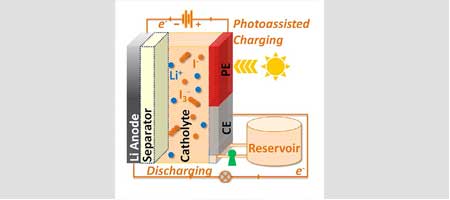More efficient, eco-friendly electricity generation with a “solar flow battery” combines a redox flow battery and a dye-sensitized solar cell, using compatible, water-based (aqueous) solvents. Solar energy is harvested and stored as chemical energy during the charging process.
When it is time to recharge the battery, the amount of energy needed to is lower than conventional lithium-iodine batteries because dye molecules, exposed to the sun, donate electrons to the recharging process.
Energy generation from a solar flow battery is more cost-effective, eco-friendly, and can achieve energy savings up to 20% compared to conventional lithium-iodine batteries. Solar flow batteries make renewable solar energy more practical for keeping the lights on and appliances running with stand-alone electricity generation and storage.
Last year, researchers at The Ohio State University demonstrated photo-assisted charging of a lithium-oxygen (Li-O2) battery; however, they used organic (carbon-based) solvents that limited its compatibility with aqueous redox flow batteries. Now, these researchers have built a solar flow battery that uses an eco-friendly, compatible solvent and requires a lower applied voltage to recharge the battery. In solar flow batteries, the proposed charging process links harvesting solar energy and storing it as chemical energy via the electrolyte.
The aqueous electrolyte is in contact with the counter electrode of the battery and the dye-sensitized photo-electrode of the solar cell. To recharge the battery, it is exposed to sunlight. The sunlight causes the dye molecules in the electrolyte to donate electrons to the photo-electrode, reducing the amount of energy needed to recharge the battery.
The applied voltage to recharge the solar flow battery is reduced to 2.9 Volts compared to over 3.6 Volts for conventional lithium-iodine batteries, resulting in an energy savings of up to 20%.
The aqueous solar flow battery performs better and is more cost-effective and eco-friendly than those based on organic solvents. The aqueous solar flow battery could solve the intermittency shortcomings of renewable energy and keep the lights on and appliances running.
Reference(s):
Publication: Mingzhe Yu, William D. McCulloch, Damian R. Beauchamp, Zhongjie Huang, Xiaodi Ren, Yiying Wu. Aqueous Lithium–Iodine Solar Flow Battery for the Simultaneous Conversion and Storage of Solar Energy. Journal of the American Chemical Society, 2015
Story: Eco-friendly Battery and Solar Cell All-in-One | Department of Energy, Office of Science — December 8, 2015














Comments